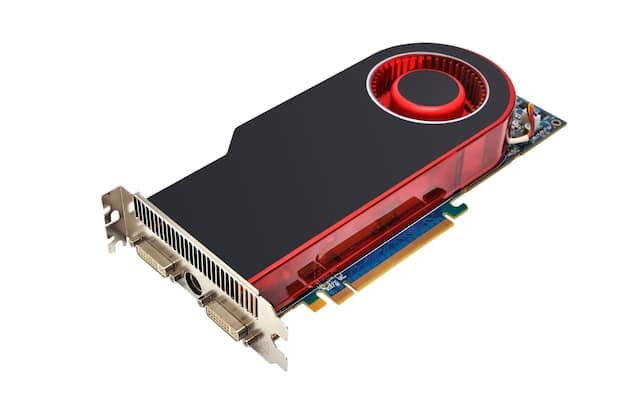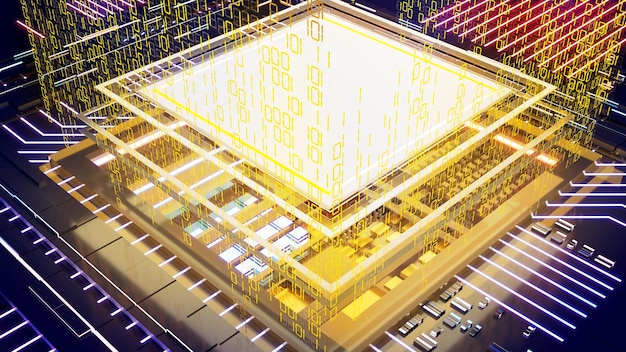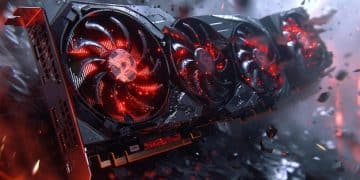AMD Ray Tracing: Performance Analysis of Current & Future GPUs

AMD is dedicated to advancing ray tracing technology in its GPUs, aiming to provide enhanced visual realism in gaming and other applications, with ongoing improvements in both performance and implementation in current and future hardware.
The world of gaming and visual computing is constantly evolving, with ray tracing emerging as a pivotal technology for achieving unparalleled realism. AMD’s commitment to ray tracing: Analyzing the performance of current and future GPUs is a journey worth exploring. Join us as we delve into AMD’s approach and analyze the impact on gaming experiences.
Understanding Ray Tracing Technology
Ray tracing is a rendering technique that simulates the way light behaves in the real world. By tracing the path of light rays and simulating their interaction with objects, it creates incredibly realistic lighting, shadows, and reflections.
How Ray Tracing Works
Traditional rendering techniques approximate lighting effects, which can sometimes lead to unrealistic visuals. Ray tracing, on the other hand, calculates the path of light rays from a virtual camera through each pixel on the screen.
- Light Simulation: Every light ray is traced as it interacts with objects in the scene.
- Reflection and Refraction: The behavior of light when it bounces off or passes through surfaces is accurately calculated.
- Realistic Shadows: Shadows are rendered more realistically by considering the size and shape of light sources.
Unlike rasterization, which is the traditional rendering method, ray tracing offers a more faithful representation of light, enhancing visual realism.
Ray tracing accurately simulates light behavior, resulting in realistic visuals compared to traditional rendering techniques.

AMD’s Initial Foray into Ray Tracing
AMD entered the ray tracing arena with the introduction of its Radeon RX 6000 series GPUs. These cards were built on the RDNA 2 architecture, which included dedicated ray accelerators, or ray tracing cores, designed specifically to handle ray tracing computations.
The RDNA 2 Architecture
The RDNA 2 architecture was a significant step forward for AMD, offering notable improvements in performance per watt and overall efficiency compared to its predecessors. The inclusion of ray accelerators marked a pivotal move toward supporting real-time ray tracing in games.
- Ray Accelerators: These cores optimized for calculating ray intersections, improving ray tracing performance.
- Hybrid Rendering: RDNA 2 supported a hybrid rendering model, combining traditional rasterization with ray tracing for the best balance of performance and visual quality.
- DirectX Raytracing (DXR): The RX 6000 series embraced Microsoft’s DXR API, ensuring compatibility with ray tracing-enabled games.
Despite these advancements, the initial performance of AMD’s ray tracing implementation lagged behind NVIDIA’s RTX cards, particularly at higher resolutions and settings.
AMD’s first ray tracing implementation with the Radeon RX 6000 series GPUs and RDNA 2 architecture marked an entry into real-time ray tracing, albeit with performance limitations compared to competitors.
Analyzing AMD’s Ray Tracing Performance
Evaluating the performance of AMD’s ray tracing involves looking at various aspects, including frame rates, visual fidelity, and the impact on overall gaming experiences. Benchmarks and real-world gaming tests provide valuable insights into the capabilities of AMD’s GPUs.
Gaming Benchmarks
Gaming benchmarks often measure the performance of GPUs using specific games and settings. When it comes to ray tracing, the results can vary significantly depending on the title and the level of ray tracing effects enabled.
- Frame Rate Impact: Enabling ray tracing generally reduces frame rates due to the increased computational load.
- Resolution Scaling: Performance degrades further at higher resolutions, such as 1440p and 4K.
- DLSS Alternatives: AMD’s FidelityFX Super Resolution (FSR) helps mitigate performance losses by upscaling lower resolution images, improving frame rates with minimal visual impact.
Performance tests reveal that while AMD’s RX 6000 series GPUs can handle ray tracing, they require careful optimization and settings adjustments to maintain playable frame rates.
Ray tracing performance on AMD GPUs varies across different games, with frame rates decreasing as ray tracing effects and resolution increase, necessitating the use of upscaling technologies like FSR.
FidelityFX Super Resolution (FSR) and Ray Tracing
AMD’s FidelityFX Super Resolution (FSR) is an upscaling technology designed to improve performance in games without significantly impacting visual quality. FSR renders games at a lower resolution and then upscales the image to the desired output resolution.
How FSR Enhances Ray Tracing Performance
By reducing the rendering resolution, FSR alleviates the computational load on the GPU, freeing up resources to handle ray tracing tasks more efficiently. This results in higher frame rates and smoother gameplay when ray tracing is enabled.
- Performance Boost: FSR provides a tangible performance boost, allowing for higher frame rates with ray tracing.
- Image Quality: FSR aims to maintain good image quality, ensuring that the upscaled image looks sharp and detailed.
- Compatibility: FSR is supported across a wide range of AMD GPUs, making it accessible to many gamers.
FSR is an essential tool for gamers looking to maximize both visual quality and performance when using AMD GPUs with ray tracing.
AMD’s FSR boosts ray tracing performance by reducing rendering resolution and upscaling the image, providing higher frame rates without sacrificing much visual quality.
Future AMD GPUs and Ray Tracing
Looking ahead, AMD is poised to continue improving its ray tracing capabilities with future GPU architectures. The RDNA 3 architecture, which powers the Radeon RX 7000 series, represents a significant leap forward in this regard.

Improvements with RDNA 3
The RDNA 3 architecture introduces several enhancements designed to accelerate ray tracing performance. These include more powerful ray accelerators, improvements to memory bandwidth, and optimizations to the overall GPU design.
- Enhanced Ray Accelerators: RDNA 3 features updated ray accelerators that offer improved performance in ray tracing tasks.
- Improved Memory Bandwidth: Increased memory bandwidth helps to reduce bottlenecks and improve overall GPU performance, including ray tracing.
- Software Optimizations: AMD continues to refine its software stack, including driver optimizations, to maximize ray tracing performance in games.
With RDNA 3, AMD aims to close the gap with NVIDIA in ray tracing performance.
Future AMD GPUs based on the RDNA 3 architecture promise significant ray tracing performance improvements through enhanced ray accelerators, increased memory bandwidth, and software optimizations.
The Competitive Landscape: AMD vs. NVIDIA
In the competitive landscape of ray tracing, AMD and NVIDIA are the two major players. NVIDIA has been at the forefront of ray tracing technology with its RTX series GPUs, but AMD is steadily catching up.
Comparative Analysis
Comparing AMD and NVIDIA in terms of ray tracing involves looking at several factors, including performance, features, and pricing. NVIDIA’s RTX cards still generally outperform AMD’s Radeon cards in ray tracing benchmarks, but AMD offers competitive pricing and a compelling value proposition.
- Performance Differences: NVIDIA’s RTX cards have a performance advantage in ray tracing, especially at higher resolutions and settings.
- Feature Set: Both AMD and NVIDIA support DXR and other ray tracing APIs, but NVIDIA’s DLSS technology often provides better image quality than AMD’s FSR.
- Pricing and Value: AMD offers more affordable GPUs that provide good ray tracing performance, making them an attractive option for budget-conscious gamers.
As AMD continues to innovate and improve its ray tracing technology, the competition between AMD and NVIDIA will likely become even more intense.
While NVIDIA currently leads in ray tracing performance, AMD offers competitive pricing and ongoing improvements, making the choice between the two brands a matter of balancing performance, features, and budget.
| Key Point | Brief Description |
|---|---|
| 💡Ray Tracing | Rendering tech for realistic lighting, shadows, and reflections. |
| 🚀RDNA 2 | AMD’s architecture with dedicated ray accelerators, starting with RX 6000 series. |
| ✨FSR | FidelityFX Super Resolution improves performance by upscaling lower res images. |
| 🔮RDNA 3 | Future architecture improvements include boosted ray accelerators and memory bandwidth. |
Frequently Asked Questions
▼
Ray tracing is an advanced rendering technique that simulates light behavior to produce realistic graphics by tracing the path of light rays in a scene.
▼
AMD implements ray tracing through dedicated hardware ray accelerators in their GPUs, starting with the RDNA 2 architecture and improving with RDNA 3.
▼
FSR is AMD’s upscaling technology that improves performance by rendering games at a lower resolution and upscaling the image to enhance frame rates.
▼
RDNA 3 enhances ray tracing through updated ray accelerators, bandwidth improvements, and software updates to maximize ray tracing capabilities.
▼
Ray tracing on AMD GPUs offers improved visual fidelity, but requires balancing the settings and taking the aid of FSR to boost performance and reach stable frame rates.
Conclusion
In conclusion, AMD’s commitment to ray tracing: Analyzing the performance of current and future GPUs showcases a steady progression towards more realism in gaming. With each generation, AMD refines and enhances its ray tracing implementation, aiming to provide gamers with immersive experiences and visual brilliance.





